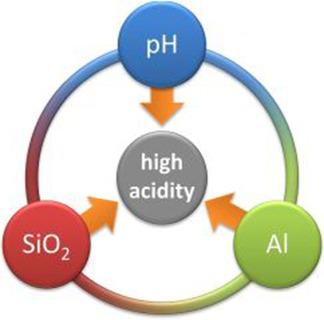当前位置:
X-MOL 学术
›
ChemCatChem
›
论文详情
Our official English website, www.x-mol.net, welcomes your
feedback! (Note: you will need to create a separate account there.)
Synthetic and Catalytic Potential of Amorphous Mesoporous Aluminosilicates Prepared by Postsynthetic Aluminations of Silica in Aqueous Media
ChemCatChem ( IF 3.8 ) Pub Date : 2018-02-14 , DOI: 10.1002/cctc.201701660 Roel Locus 1 , Danny Verboekend 1 , Martin d'Halluin 1 , Michiel Dusselier 1 , Yuhe Liao 1 , Nicolas Nuttens 1 , Tony Jaumann 2 , Steffen Oswald 2 , Luís Mafra 3 , Lars Giebeler 2 , Bert Sels 1
ChemCatChem ( IF 3.8 ) Pub Date : 2018-02-14 , DOI: 10.1002/cctc.201701660 Roel Locus 1 , Danny Verboekend 1 , Martin d'Halluin 1 , Michiel Dusselier 1 , Yuhe Liao 1 , Nicolas Nuttens 1 , Tony Jaumann 2 , Steffen Oswald 2 , Luís Mafra 3 , Lars Giebeler 2 , Bert Sels 1
Affiliation

|
Amorphous aluminosilicate catalysts have been used industrially on a large scale for almost a century. However, the influence of the pH on the alumination of silica in aqueous solutions has remained largely unclear. Herein, room temperature aluminations of different mesoporous amorphous silicas (fumed silica, dried silica gel, SBA‐15, MCM‐41, and COK‐12) with aqueous solutions of various pH (3–13) are explored. The aqueous solutions are prepared using different aluminum sources (Al(NO3)3 or NaAlO2) and alkaline additives (NaOH or NH4OH). The decoupling of pH and Al source using alkaline additives results in a vast experimental potential to prepare unique aluminosilicates, whereby an important role is played by the pH development during the treatment. The bulk and surface composition, acidity, aluminum coordination, morphology, hydrothermal stability, and porosity of the obtained materials are characterized. Optimal samples possess large surface areas and superior acidities (up to 50 % higher) and outstanding stabilities compared to aluminosilicates prepared with state‐of‐the‐art methods. The obtained materials are evaluated in a series of acid‐catalyzed model reactions involving substrates of various chemical reactivity and size, enabling insight in the catalytic functionality of the introduced Brønsted and Lewis sites. The potential of the obtained materials is emphasized by the similar or superior acidity and catalytic performance compared to several benchmark industrial silica–alumina‐based catalysts.
中文翻译:

二氧化硅在水介质中的后合成铝化反应制备的非晶态介孔铝硅酸盐的合成和催化电势
非晶态铝硅酸盐催化剂已经在工业上大规模使用了近一个世纪。然而,pH值对水溶液中二氧化硅的铝化作用的影响仍然不清楚。在此,研究了不同介孔无定形二氧化硅(气相法二氧化硅,干燥的硅胶,SBA-15,MCM-41和COK-12)在各种pH值(3-13)的水溶液中的室温铝化。使用不同的铝源(Al(NO 3)3或NaAlO 2)和碱性添加剂(NaOH或NH 4)制备水溶液哦)。使用碱性添加剂将pH和Al源分离,在制备独特的硅铝酸盐方面具有巨大的实验潜力,因此在处理过程中pH的发展起着重要的作用。表征了所得材料的体积和表面组成,酸度,铝配位,形态,水热稳定性和孔隙率。与采用最新方法制备的铝硅酸盐相比,最佳样品具有较大的表面积和优异的酸度(最高可提高50%),并具有出色的稳定性。在一系列酸催化的模型反应中评估获得的材料,这些反应涉及具有不同化学反应性和大小的底物,从而使您能够洞悉引入的Brønsted和Lewis位点的催化功能。
更新日期:2018-02-14
中文翻译:

二氧化硅在水介质中的后合成铝化反应制备的非晶态介孔铝硅酸盐的合成和催化电势
非晶态铝硅酸盐催化剂已经在工业上大规模使用了近一个世纪。然而,pH值对水溶液中二氧化硅的铝化作用的影响仍然不清楚。在此,研究了不同介孔无定形二氧化硅(气相法二氧化硅,干燥的硅胶,SBA-15,MCM-41和COK-12)在各种pH值(3-13)的水溶液中的室温铝化。使用不同的铝源(Al(NO 3)3或NaAlO 2)和碱性添加剂(NaOH或NH 4)制备水溶液哦)。使用碱性添加剂将pH和Al源分离,在制备独特的硅铝酸盐方面具有巨大的实验潜力,因此在处理过程中pH的发展起着重要的作用。表征了所得材料的体积和表面组成,酸度,铝配位,形态,水热稳定性和孔隙率。与采用最新方法制备的铝硅酸盐相比,最佳样品具有较大的表面积和优异的酸度(最高可提高50%),并具有出色的稳定性。在一系列酸催化的模型反应中评估获得的材料,这些反应涉及具有不同化学反应性和大小的底物,从而使您能够洞悉引入的Brønsted和Lewis位点的催化功能。









































 京公网安备 11010802027423号
京公网安备 11010802027423号